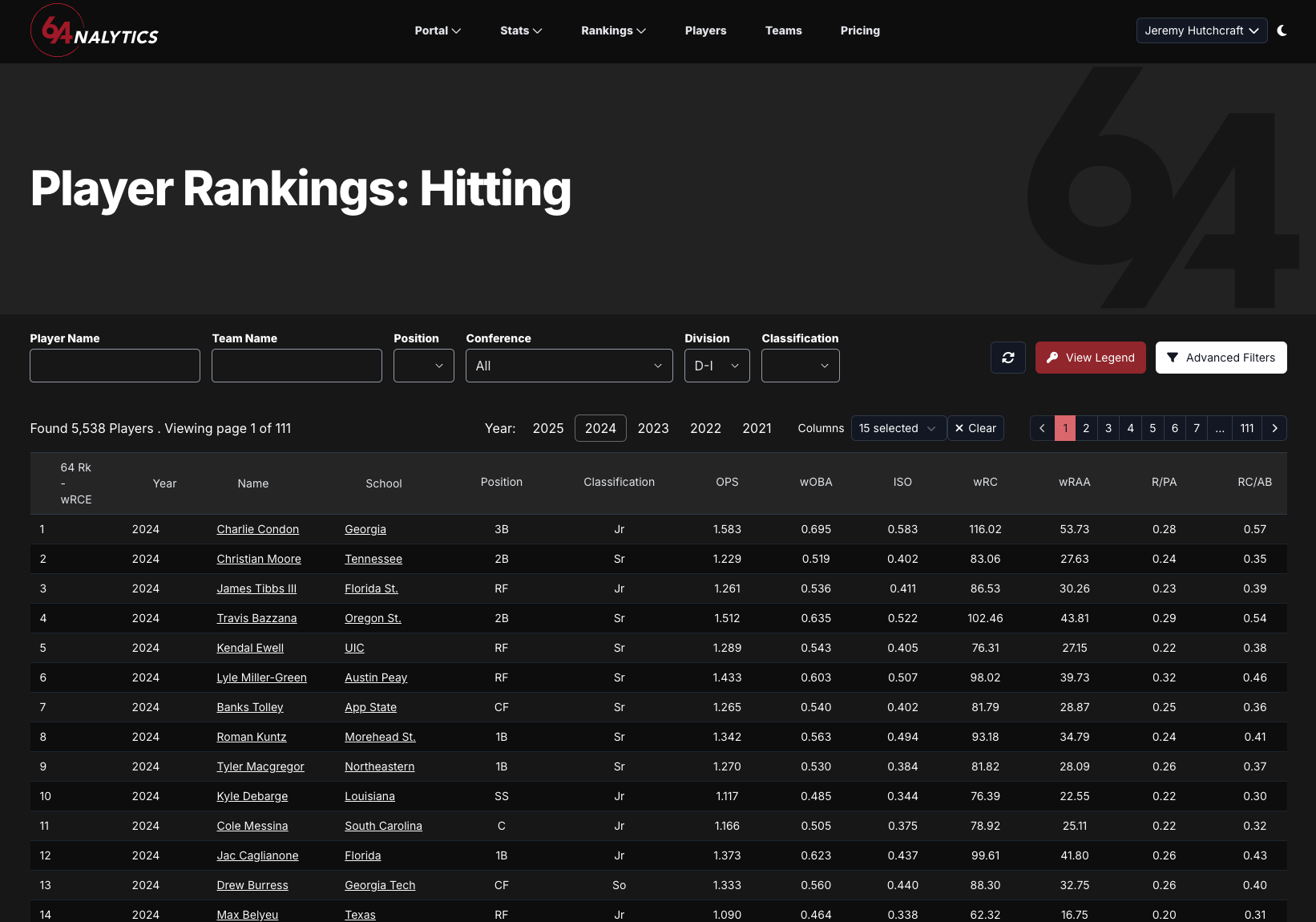At 64Analytics, we are proud to introduce two groundbreaking metrics that bring clarity and precision to college baseball analytics: Weighted Run Allowed Efficiency (wRAE) and Weighted Run Created Efficiency (wRCE). These advanced statistics refine Bill James’ iconic Run Created formula, first introduced in his 1985 Historical Baseball Abstract, adapting it to the unique characteristics of the college game.
— 64Analytics (@64Analytics) March 14, 2024
The Foundation: Bill James’ Formula
James’ original Run Created formula calculated offensive performance by combining hits and walks, multiplying the total by the total bases, and dividing the product by at-bats. While revolutionary for its time, the formula assumes a relatively consistent skill level among professional players—an assumption that doesn’t hold in the diverse landscape of college baseball.
Why Adapt for College Baseball?
College baseball is defined by its variability. From Division I powerhouses to Division III programs, the disparity in talent, competition levels, and scoring environments is significant. To address this, wRAE and wRCE incorporate a range of contextual factors, including:
- Series Type: Whether the game is part of a weekend series or a midweek matchup.
- Opponent Context: The quality of the opposing team, including conference and divisional RPI rankings.
- Player Averages: Comparing individual performances to divisional averages and team benchmarks.
- Pitcher’s Performance: Evaluating outcomes relative to the average runs the opposing pitcher allows.
These adjustments ensure that our metrics provide a comprehensive and context-aware evaluation of player performance, moving beyond raw numbers to deliver actionable insights.
How wRCE Works
Let’s break it down with an example. During a 2024 midweek game between the Florida State Seminoles and the Florida Gators, Daniel Cantu went 3-for-3, tallying two runs, two RBIs, and two walks. At first glance, it is a strong performance—but wRCE dives deeper.
Cantu’s contributions included a double and two singles, accounting for four total bases. Using James’ formula, this translates to four runs created. Dividing by his three at-bats yields a run created per at-bat of approximately 1.33.
Next, wRCE evaluates this figure against three benchmarks:
- Cantu’s Seasonal Average: How this performance stacks up against his season-long contributions.
- Division I Averages: How does it compare to the overall average at the Division I level?
- Pitcher’s Context: The run allowance profile of the opposing pitcher on that specific date.
By incorporating these variables and applying weighting adjustments, wRCE provides a more nuanced picture of Cantu’s performance, contextualizing its impact beyond the surface-level box score.
Introducing wRAE
While wRCE focuses on hitters, Weighted Run Allowed Efficiency (wRAE) delivers the same granular insight for pitchers. It evaluates a pitcher’s ability to minimize scoring opportunities while accounting for opponent quality, game context, and team-level defensive support. Together, wRAE and wRCE offer a complete picture of how runs are created and prevented in college baseball.
Why It Matters
Our metrics aggregate data across over 950 college baseball teams, spanning all three divisions. This breadth enables detailed comparisons and insights, empowering coaches, players, and analysts to:
- Identify standout performances in varying contexts.
- Evaluate players relative to their peers at both team and divisional levels.
- Make data-driven decisions that elevate team strategy.

Elevating College Baseball Analytics
At 64Analytics, we are enthusiastic about the transformative potential of wRAE and wRCE. These metrics bring professional-grade precision to the college game, addressing its unique challenges and unlocking new avenues for understanding player contributions.
We invite you to explore these intuitive metrics and see how they can reshape your approach to college baseball analytics. Welcome to the next era of insight, where context meets performance.
